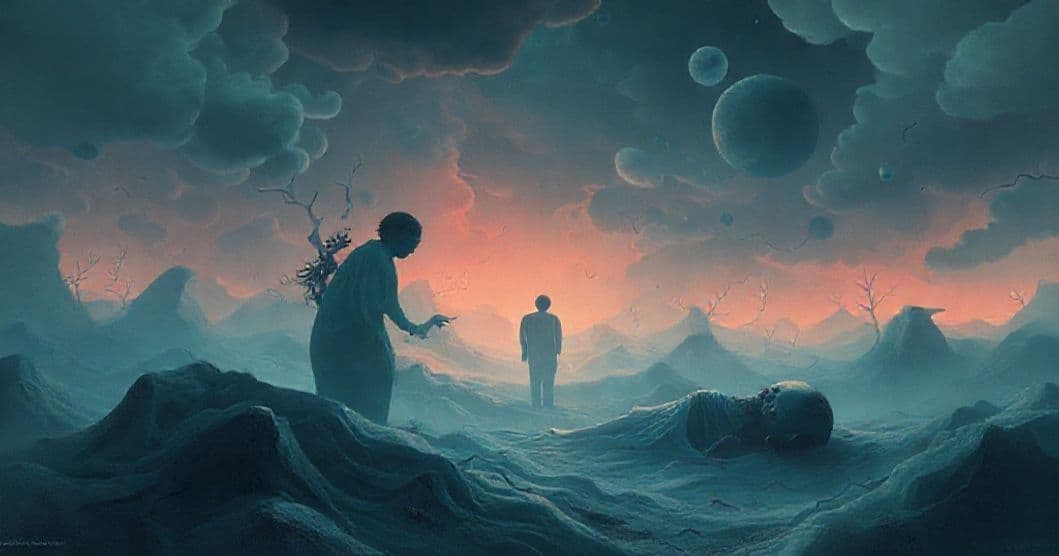Part 1: Dream Presentation
Dreams of death can feel like psychological alarms, jarring us from sleep with their visceral intensity. This recurring dream pattern reveals a deeper dialogue between the conscious and unconscious mind, as explored in this dream narrative:
Lately, my sleep has become a battlefield of strange endings. I’ve been haunted by dreams where people die—not just once, but repeatedly, in ways both violent and serene. It started subtly, with a single dream of a loved one passing peacefully in their sleep, but now it’s relentless: strangers collapsing in traffic, friends drowning in dark waters, faceless figures with eyes closed, their breath stilling. Some deaths are quick—sharp, sudden, like a knife in the chest or a car crash’s screech—but others unfold slowly, like an elderly woman’s final breath on a hospital bed, or a child’s gentle, painless departure. The faces blur sometimes, but the emotions are vivid: the terror of witnessing, the sadness of loss, the surreal calm of watching something inevitable unfold. What terrifies me most is the frequency—almost every night now, I wake gasping, heart racing, sheets soaked with sweat. The people dying aren’t always familiar: some I recognize from childhood, others I’ve never seen before, their features shifting like smoke. I’ve tried Googling, and the results say these dreams mean new beginnings, but they feel anything but fresh. They feel like endings, of something I can’t yet name, and I’m losing sleep trying to understand what they’re trying to tell me.
Part 2: Clinical Analysis
Want a More Personalized Interpretation?
Get your own AI-powered dream analysis tailored specifically to your dream
🔮Try Dream Analysis FreeSymbolic Landscape: The Language of Death in Dreams
Death imagery in dreams rarely signifies literal mortality; instead, it acts as a symbolic messenger. The variety of death scenes—the violent car crash, the peaceful hospital passing, the faceless stranger—suggests multiple themes converging. Violent deaths often represent abrupt endings or suppressed anger, while peaceful deaths may signify acceptance or the need to release control. The presence of both known and unknown people introduces layers of personal and collective unconscious themes: loved ones dying may reflect unresolved relationships or fears of loss, while strangers could symbolize new aspects of self or unprocessed social anxieties. The dream’s frequency (almost nightly) indicates emotional urgency—your mind is fixating on these themes because they demand attention.
Psychological Perspectives: Understanding the Unconscious Dialogue
From a Jungian perspective, death dreams often represent psychological transformation—the “great mother” archetype of endings as necessary for rebirth. Freud might interpret them as repressed aggressive impulses or unresolved grief, while modern cognitive neuroscience frames dreams as emotional processing tools, helping the brain integrate stress and trauma. The contrast between violent and peaceful deaths could reflect internal conflict: do you feel overwhelmed by life’s chaos (violent) or seeking solace in surrender (peaceful)? The unknown faces may represent shadow aspects of yourself you haven’t acknowledged, while the recurring nature suggests a message you’ve yet to decode. Your sleep disruption (gasping, racing heart) indicates the dream’s emotional charge is activating your sympathetic nervous system, signaling that these themes are too urgent to ignore.
Emotional & Life Context: Unpacking the “Unnamable Ending”
Dreams of death often surface during periods of significant change or uncertainty. Consider: Are you undergoing major life transitions (career, relationships, identity shifts)? Do you feel pressure to “end” old behaviors or relationships but resist? The “new beginnings” interpretation from Google may feel hollow because your emotional experience is one of loss, not rebirth—this disconnect suggests your unconscious is processing grief before you’re ready to embrace change. The recurring strangers could symbolize social roles you’re shedding or fears of unfamiliar challenges. Your inability to sleep highlights the emotional weight of these dreams: they’re not just “messages”—they’re warnings your body and mind are sending to protect you from emotional overload.
Therapeutic Insights: Transforming Fear into Understanding
To integrate these dreams, start with journaling: document the specific emotions in each death scene (fear, sadness, calm) and note waking associations. Ask: Which death feels most familiar? What ending in my life feels unresolved? Consider that death in dreams often represents letting go—of a job, a relationship, a self-perception. The “peaceful death” might be a metaphor for accepting impermanence, while “violent death” could signal anger at being “cut off” from something vital. Practical steps: create a “dream ritual” before bed to process emotions, practice mindfulness to reduce sleep anxiety, and explore if there’s a pattern in your waking life that mirrors these endings (e.g., avoiding necessary conversations, resisting change). Remember: dreams don’t predict the future—they predict how you’re feeling about the future.
FAQ Section
Q: Why do I dream of strangers dying?
A: Strangers often represent parts of yourself you haven’t claimed or social roles you’re outgrowing. These deaths may signal the need to “die” to old identities to make space for new growth.
Q: Are these dreams about my own mortality?
A: While existential fears play a role, death dreams typically reflect emotional endings, not physical ones. They’re more about letting go of what no longer serves you than fearing death itself.
Q: How can I tell if these dreams are healthy or pathological?
A: Healthy dreams resolve over time with reflection; pathological ones cause persistent trauma or panic. If your sleep deprivation affects daily life, consider talking to a therapist to explore underlying stressors.
